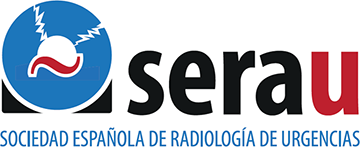Hospital: HOSPITAL UNIVERSITARIO DE 12 OCTUBRE.
Nº: C2019-591
Aut@r o Autores: E. Martinez-Chamorro, L. Ibañez, C. Casado, I. Navas, S. Nagrani, S. Borruel.
Presentación
A 38-year-old man with no remarkable medical history was admitted to the Emergency Room for a 2-days history of intense right-sided parasternal chest pain. Electrocardiogram and laboratory tests including cardiac enzymes were normal. Physical examination only revealed hypoventilation at the base of the right hemithorax. Chest X-ray showed elevation of right hemidiaphragm. Due to the persistence and intensity of pain contrast-enhanced CT was performed. It revealed a well-encapsulated ovoid fatty attenuating lesion with mild adjacent fat stranding in the righ epipericardial fat, consistent with epipericardial fat necrosis. There were no findings of acute pulmonary embolism, acute aortic pathology or osseus abnormality. He was treated with nonsteroidal antiinflammatory analgesics. At followup, two months later the patient was asymptomatic and chest X-ray showed no alterations.
Discusión
Epipericardial fat necrosis is an uncommon cause of chest pain, although its true incidence is unknown and probably is underestimated. It typically presents as acute pleuritic chest pain in otherwise healthy patients. Laboratory data and ECG findings are characteristically normal. Chest radiographs are often normal during the first few days, but usually will progress revealing an ill-defined round mass overlying the ipsilateral cardiophrenic angle on the same side of the chest pain. CT findings are diagnostic. Similarly to fat necrosis in other more common locations like epiploic appendagitis, CT shows an encapsulated, round or ovoid fat-containing lesion with adjacent fat stranding within epicardial or pericardial fat. It occurs more likely on the left side than on the right side of the hemithorax. Other associated findings include pericardial thickening, small ipsilateral pleural effusion and minor pulmonary atelectasis. It has typically a benign, self-limited course and conservative treatment with antiinflammatory agents is indicated. The pain gradually subsides and resolves within several days. A follow-up CT examination is usually recommended to confirm resolution of the findings.
Conclusión
Epipericardial fat necrosis is a benign self-limited condition that should be considered in patients with acute chest pain, without associated symptons and with normal physical and analytical examinations. CT findings usually are diagnostic, so radiologists should be aware of the characteristic imaging findings in order to establish the correct diagnosis and avoid aggressive techniques.
Bibliografía
- Giassi KS, Costa AN, Bachion GH, Kairalla RA, Filho JRP. Epipericardial fat necrosis: who should be a candidate?. AJR 2016, 207:773-7. - Nguyen DN, Tran CD, Rudkin SM, Mueller JS, Hartman MS. Epipercardial fat necrosis: Uncommon cause of acute pleuri


